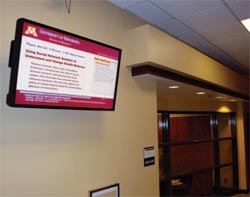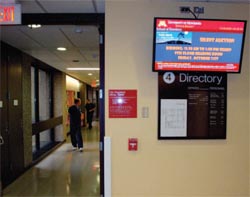UNIVERSITY OF MINNESOTA'S FAST-GROWING DIGITAL SIGNAGE SYSTEM PROVES HIGHLY RELIABLE.
It's the Maytag repairman revisited. With nearly 100 people on University of Minnesota campuses creating slides for their digital signage network, U of M AV customer service representative Eric Topping says they average just "one or two" support
NEC LCD screens are strategically located at entryways near office directories on two campuses of the University of Minnesota. Photo by Don Kreski calls per month.
"I would say that we typically field one or two calls in the first 1 1/2 weeks of a new deployment," Topping explains. "Beyond that we get two phone calls a year from various people at that department."
Yet the system, based on a Tightrope Carousel Enterprise Server, is currently in use by 20 colleges and/or departments on two U of M campuses, ranging from the School of Dentistry to the Department of Emergency Management, from Electrical Engineering and Computer Science to Facilities Management. The University is adding new monitors to the network at a 387% annual rate.
CRUCIAL INFORMATION
"One of the biggest reasons we installed a digital signage system is that we worried that students were not getting crucial information," says Topping. "We all get tons of email. If the title doesn't grab peoples' attention, who's to say they don't delete it?" According to Topping, the system has largely solved the problem by bringing bulletins to students and staff just when they need them at the locations where they're most likely to act on them.
Wanda Marsolek, operations manager for the University's Classroom Technical Services department (CTS), reports that "each department has its own channel and creates its own content." Currently the system is used for departmental bulletins, guest speaker announcements, special events promotion, reminders, room scheduling information, building directories, and announcements of continuing education courses. "They can just create the content, and the people in their area are quickly and directly aware of it," she explains. In addition, many departments are also including video news and weather feeds in a corner of the screen, and some stream information from their websites.
"We're also working with the University Sign Committee to allow the installation of digital signage in outdoor locations," says Topping. "This will especially apply to interactive kiosks for wayfinding, general University information such as athletics events, and, naturally, Emergency Management." As Tightrope introduces an interactive version of Carousel, Topping hopes to use the system for interactive campus and building directories, digital "for sale" corkboards, classroom reservations, and ticket sales and purchases of bus passes.
Growth has been rapid. In May, 2007 the signage system included eight displays across the campus. By May 2008, there were 31. By August, the University had 15 more installed with an additional 102 planned for installation within the next 12 months.
DETAILS OF THE SYSTEM
For smaller signage networks, Tightrope Media offers hardware-based server and player options. But at the University of Minnesota, they provided a software licensing solution for U of M's own servers and player hardware that the University purchased directly from the company that supplies Tightrope.
Marsolek says that Classroom Technical Services installs the players and monitors and coordinates with Facilities Management and Telecommunications for electrical and networking. Most often they use a 40-inch NEC LCD display, but sometimes departments choose a larger monitor. "We have a couple of technicians assigned to install the hardware," says Marsolek. "It's real easy, quick, and efficient, and the more they install, the faster it goes."

that anybody could just log on to. And we wanted to have an approval scheme already set up so a clerical worker could create and schedule messages, and then a manager could review them and approve them for posting."
Another consideration was cost. "Some of the other systems were extremely expensive," Bottemiller notes. "Everybody else has a very high licensing cost per site. What they expect you to do is use one player to cover a given area, then set up an RGB infrastructure to send the signal to your various monitors. That model didn't work very well for us, because it would have been very costly to install all the coax cable, while we already had data infrastructure everywhere."
Instead, the University purchased a large number of players and installed them on the University's IP network, in most cases running just one monitor from each. "If we had used another firm and set it up that way, we would have been paying $3,000 to $4,000 per year per player, and that was just unacceptable." Topping adds that, "it's just a matter of specifying the IP addresses for the players that will receive a particular channel."
A third consideration was flexibility. The Carousel system allows U of M to divide the monitor screen into several zones, each of which can originate from a different source. "It's easy to set up zones in various shapes, sizes, and configurations," Topping adds.
Topping says that training and support have been minimal. "We do offer a training session where we walk them through just about every facet of the signage software. I don't expect everybody to retain 100 percent of the information at that time, but at least they have seen it once, and that helps their learning process." Content creation is easy and intuitive.
LINKS TO OTHER UNIVERSITY SYSTEMS
Topping says that the University is making a big effort to streamline its systems and eliminate multiple points of entry for the same data.
"We expect to see a lot of use of the signage systems for room scheduling," he reports, once CTS ties Carousel into Resource 25 (R25), the University's scheduling system. "Each department will be able to interface Carousel to the Resource 25 server, and that will automatically pull the data for each room. Then, as the room schedule is updated in R25, the schedule is automatically updated at the display location. The information is refreshed every five minutes."
The Emergency Management team, who has been very supportive of the signage system, is also looking at tying Carousel into their other systems.
Right now, Carousel is set up so that the department can override any or all of the signage system's messaging channels should there be an emergency on campus. But signage is not their only emergency notification method, and they need to originate messages in their text messaging, email, radio alert, and other systems separately. "It turns out that Carousel is able to output information on an RSS basis, also," Topping says, "so one of my long term projects is to see if we will be able to refine the process to where we can create content within Carousel, then output the messages to the other systems."
According to Topping, this is just one more reason why the signage system continues to grow so quickly on campus. "We feel digital signage and interactive digital signage can revolutionize the overall experience faculty, staff, students, and guests have at the University of Minnesota. CTS is striving to turn this vision into a reality."
INFO
NEC: www.necvisualsystems.com
TIGHTROPE MEDIA SYSTEMS:www.trms.com
